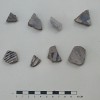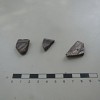
| Culture | Branch | Tradition | Ware | Type |
| Ancestral Pueblo: Greater Upper Rio Grande Valley | Northern Rio Grande | Taos (Northern Tiwa) | Taos White Ware | Talpa Black-on-white |
Type Name: Talpa Black-on-white |
|
| Period: | 1250 A.D. - 1400 A.D. |
| Culture: | Ancestral Pueblo: Greater Upper Rio Grande Valley |
| Branch: | Northern Rio Grande |
| Tradition: | Taos (Northern Tiwa) |
| Ware: | Taos White Ware |
First posted by C. Dean Wilson 2014
Talpa Black-on-white was defined by Dick (1965). This type refers to organic painted pottery known to have been produced in the Taos and Picuris areas during the late Coalition through early Classic periods from about A.D. 1250 to 1400 (Dick and Adler 1999; Wetherington 1968). Talpa Black-on-white type developed out of earlier forms that would be assigned to Santa Fe Black-on-white which appear slightly earlier and is part of a larger trend of the production of the production of regionally distinct types similar to but distinguished from Santa Fe Black-on-white by difference in paste, temper, surface finish, and sometimes by nuances in design styles. Talpa Black-on-white is commonly associated with Taos and Santa Fe Black-on-white and smeared corrugated utility wares.
This type is distinguished from earlier Santa Fe Black-on-white by a distinct coarse dirty paste. Temper consists of coarse quarz and arkosic sand, and paste is white to dark gray with occasional carbon streaks. Forms are almost exclusively represented by bowls with a thin wash and painted decorations on the interior but are usually unpainted on the interior. Bowl interiors range from those with well-polished exteriors to those that are rough and unpolished. Later examples of Talpa Black-on-white tend to be softer and more friable and may reflect trends toward lower firing temperatures. Rims are usually tapered and unpainted. Designs are executed in a black organic paint and usually consist of band patterns often framed by a single isolated design. Designs commonly consist of large linear elements such as pendant triangles. Other motifs include checkerboards, ticked and barbed lines, small circles, and hatched designs.
References:
Adler, Michael A. and Herbert W. Dick
1999 Picuris Pueblo Through Time: Eight Centuries of Change at a Northern Rio Grande Pueblo. Williams Clements Center for Southwest Studies, Southern Methodist University.
Dick, Herbert W.
1965 Picuris Pueblo Excavations, Clearing House, Springfield, Virgina.
Wetherington, Ronald K.
1968 Excavations at Pot Creek Pueblo. Fort Burgwin Research Center Report No. 6. Taos.
Related Photos
 © New Mexico Office of Archaeological Studies, a division of the New Mexico Department of Cultural Affairs.
© New Mexico Office of Archaeological Studies, a division of the New Mexico Department of Cultural Affairs.
The Center for New Mexico Archaeology
7 Old Cochiti Road
Santa Fe, NM 87507
505-476-4404
Fax: 505-476-4448


